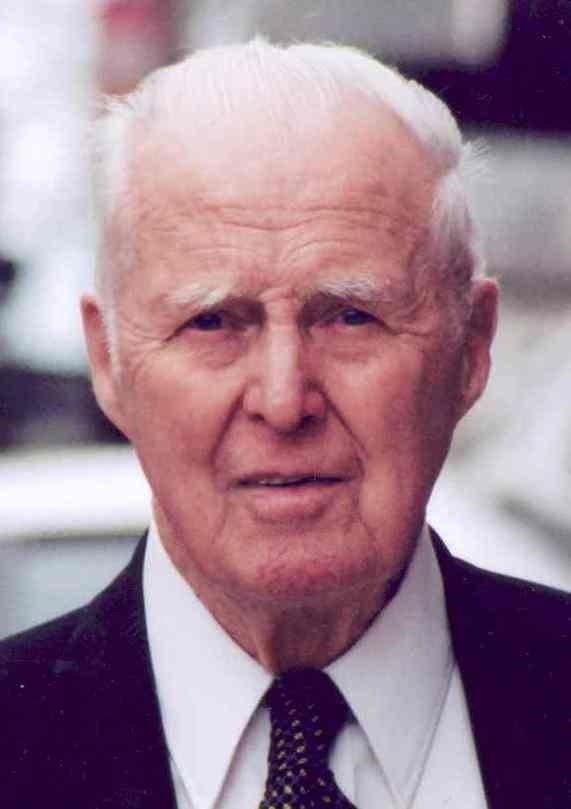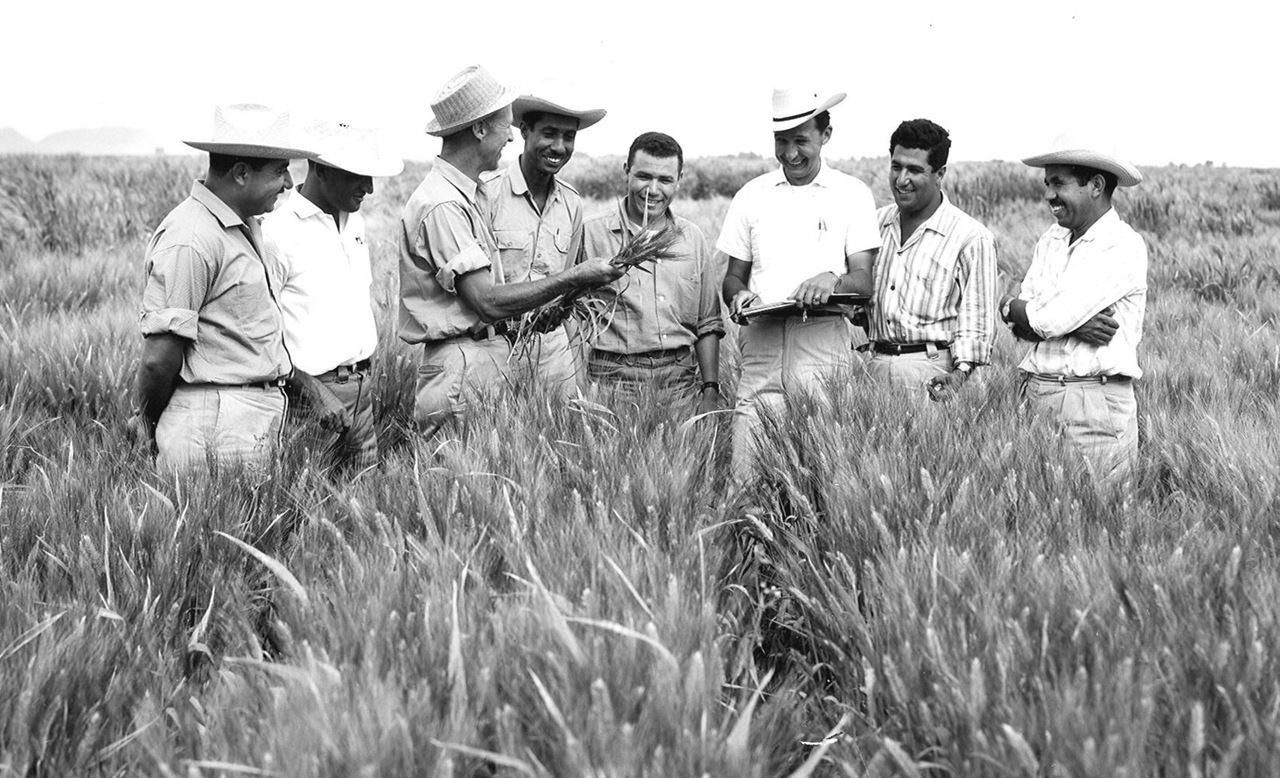"If you desire peace, cultivate justice, but at the same time cultivate the fields to produce more bread" - Norman Borlaug
 Norman Ernest BorlaugBen Zinner, USAID, Public domain, via Wikimedia CommonsAn endless expanse of golden wheat swayed, ever so gently, to the gusts of wind. A sweltering heat pounded onto the shoulders of men who sat, toiling away, at the center of the field. Sweat, soaking wet sweat, poured down their foreheads. One stood up, apart from the others, and in a calm yet authoritative voice, spoke. He spoke of the wheat upon which they looked, of the soil upon which they stood, and of the mission upon which he came. This was he, the man who would go on to save a billion lives, on to revolutionize wheat crop, on to become the father of the Green Revolution. This was he: Norman Ernest Borlaug. Born in the heart of America in 1914, Borlaug spent his early years battling the hardships of the Great Depression. By 1944, he had graduated from the University of Minnesota and began work for the Rockefeller Organization in developing Mexico's agricultural growth. During the subsequent years, Borlaug and his colleagues developed wheat varieties and agricultural techniques that transformed the agronomic landscape of multiple developing countries. This led to an increase in overall food supply, inadvertently saving hundreds of millions of people from starvation. Borlaug was a tireless crusader towards deterring world starvation, and a truly inspirational figure. The fortitude in inspiring change, the devotion to improvement, and the persevering character that he possessed throughout his life gave him the capability to overstep past the roles of a scientist, and into a paradigm of revolution.
Norman Ernest BorlaugBen Zinner, USAID, Public domain, via Wikimedia CommonsAn endless expanse of golden wheat swayed, ever so gently, to the gusts of wind. A sweltering heat pounded onto the shoulders of men who sat, toiling away, at the center of the field. Sweat, soaking wet sweat, poured down their foreheads. One stood up, apart from the others, and in a calm yet authoritative voice, spoke. He spoke of the wheat upon which they looked, of the soil upon which they stood, and of the mission upon which he came. This was he, the man who would go on to save a billion lives, on to revolutionize wheat crop, on to become the father of the Green Revolution. This was he: Norman Ernest Borlaug. Born in the heart of America in 1914, Borlaug spent his early years battling the hardships of the Great Depression. By 1944, he had graduated from the University of Minnesota and began work for the Rockefeller Organization in developing Mexico's agricultural growth. During the subsequent years, Borlaug and his colleagues developed wheat varieties and agricultural techniques that transformed the agronomic landscape of multiple developing countries. This led to an increase in overall food supply, inadvertently saving hundreds of millions of people from starvation. Borlaug was a tireless crusader towards deterring world starvation, and a truly inspirational figure. The fortitude in inspiring change, the devotion to improvement, and the persevering character that he possessed throughout his life gave him the capability to overstep past the roles of a scientist, and into a paradigm of revolution.
Norman Borlaug's overall desire to make a difference in agriculture was evident throughout his career. Looking back on the work that was done to increase wheat supply, and on the results that were achieved, Dr. Per Pinstrup-Andersen said: "The contributions of Borlaug and his colleagues are highly visible in the countryside of many developing countries, including China, India, Pakistan, Bangladesh, and Mexico. Poor farmers gained access to high-yielding varieties of wheat and maize that were developed under the leadership of Borlaug" (Pinstrup-Andersen). As a result of the decade's work that Borlaug and his team had put into changing the agricultural landscape, developing communities were being affected for the better. This was achieved partly because of the drive to instigate such dramatic change that Borlaug had put in to succeed. Borlaug's resolve in creating change allowed for his work to have dramatic effects on the food supply of these countries. In his Nobel speech, Borlaug continued to advocate and inspire for agricultural reform: "If you desire peace, cultivate justice, but at the same time cultivate the fields to produce more bread" (Borlaug). Borlaug stressed the importance of society to aid developing countries in their agricultural needs, so that they may continue to exist. In saying this, he wanted to motivate for change. He himself couldn't change the world in his own lifetime; by reaching out to the people through his speech, his aspirations could be heard and acted upon. Borlaug's desire to change agriculture ultimately ended in countries being affected for the better.
Norman Borlaug's will to revolutionize agriculture played hand in hand with his determination past the naysayers and work circumstances. As Henry Miller, a personal friend, put it: "In his professional life, Borlaug struggled against prodigious obstacles, including what he called the 'constant pessimism and scare-mongering' of critics and skeptics who predicted that in spite of his efforts, mass starvation was inevitable and hundreds of millions would perish in Africa and Asia. His work resulted not only in the construction of high-yielding varieties of wheat but also in new agronomic and management practices that transformed the ability of Mexico, India, Pakistan, China, and parts of South America to feed their population" (Miller). Despite having his work mocked, Borlaug looked past the criticism and strove wholeheartedly towards his goals. Everyone knew that saving millions was near impossible, yet Borlaug continued on, and on, and on, until he could say that his ambitions had been met. Again, Borlaug's perseverance past the pessimists showed that he would not step down from that which he truly cared about, resulting in the transformation of countries' ability to produce food. Throughout much of his professional career, Borlaug worked for various organizations and for the United States government. Miller continued on with the nature of his work in these organizations: "Although he worked under the auspices of the Rockefeller Foundation, this was no pampered boffin working in sparkling, state-of-the-art labs; Vietmeyer's account describes vividly the primitive and sometimes dangerous conditions that Borlaug endured in Mexico" (Miller). Borlaug did not do the work that he did for the sake of comfort and luxury. Instead, he worked through the "sometimes dangerous" conditions that came up. He did not pay attention to his own well being when working in Mexico, instead focusing on his true mission. Borlaug's perseverance in helping the world cure its food supply was matched only by the eagerness that he had in constantly improving.
Borlaug's dedication to continual improvement drove him to excel in his cause. After spending thirteen years developing new wheat varieties to combat rust, a prevalent fungal disease that affected wheat, Borlaug and his team had success, as "by 1957... a number of new lines had been released; 70 percent of area cultivated to wheat was seeded to these new varieties. The national average yield had been increased from 11.5 to 20 bushels per acre as the depredations of the rust had been checked. This was success, unprecedented and unquestionable" (Paarlberg). However, he was not finished: "Had Borlaug been only a pathologist, which was the area of his training, he might have congratulated himself on a job well done and tapered off his work sometime during the fifties... But not Norman Borlaug. He saw the big picture; he subscribed to the primary objective, which was wheat improvement" (Paarlberg). Throughout his career, Borlaug constantly exceeded what expected. Even though the decade's worth of work that he had put in was rewarded, he did not quit in his broader endeavor. This desire to do more than just simply stop wheat rust led him to fight towards the greater aspect of "wheat improvement." After having spent his entire life researching solutions regarding this, Borlaug's work never stopped: "In spite of his advanced age, Borlaug continued to travel extensively in the first decade of the twenty-first century, giving lectures and seminars, advising governments, training younger scientists and agricultural development experts around the world, and, as the leader of the Sasakawa Africa Association, promoting productivity increases in African agriculture" (Pinstrup-Andersen). Borlaug did not want his team's work to be squandered. He strove to continue the revolution, even as he grew older and weaker, to inspire others to continue in his footsteps. He was not merely a scientific figure, but a humanitarian symbol. Borlaug pushed the envelope in reaching out to the community through his travels, speeches, and seminars. In the end, Borlaug's resolve in doing more than what was needed showed a will to succeed, and a will to revolutionize the field of agriculture.
 Dr. Borlaug training scientistsInternational Maize and Wheat Improvement Center - Flickr [Public domain]
Dr. Borlaug training scientistsInternational Maize and Wheat Improvement Center - Flickr [Public domain]
Norman Borlaug's perseverance, determination to instigate change, and commitment to progress portrayed him as a man who refused to accept boundaries, and as a man who would transform the world. His life's unparalleled devotion towards agriculture spoke volumes of his character, of his dreams, and of his accomplishments. He braved the harshness of critics, politicians, and working conditions to rise above the masses and create a revolution. Ultimately, his work permitted for drastic improvements in the countries touched by his footprint. During his time, "wheat yield per acre rose fourfold from 1944 to 1970. Mexico, which had previously had to import wheat, became a self-sufficient cereal-grain producer by 1956" (Lobb). And through all this, he did not let anything hold him back. By the twenty-first century, Borlaug did not halt his work; he continued to inspire our community. The man who had personally seen pain and suffering during the Great Depression had created a solution. With purely scientific work, he created humanitarian consequences. To me, Borlaug is an inspiration because he used his work to look directly at the source of starvation, and solve it at its core. While others created charities and organizations that danced around the issues plaguing our world for the sake of monetary gain, Borlaug braved obstacles and fought for the sake of our society's improvement. Norman Borlaug passed away five years ago, but his revolution continues to this day. The man whose sole purpose was to better society has passed away, but the passion and drive, the will and strength, the perseverance and good nature that compelled him to work and succeed will continue to live on through us. And that man, who stood in the midst of an expanse of golden wheat, using its seed to create a revolution, will never be forgotten.
Works Cited
Lobb, Richard L. "Green Revolution." Encyclopedia of Food and Culture. Ed. Solomon H. Katz. Vol. 2. New York: Charles Scribner's Sons, 2003. 155-157. Gale Virtual Reference Library. Web. 23 Mar. 2014.
Miller, Henry I. "Norman Borlaug: The Genius Behind The Green Revolution." Forbes. Forbes Magazine, 18 Jan. 2012. Web. 20 Mar. 2014. <http://www.forbes.com/sites/henrymiller/2012/01/18/norman-borlaug-the-genius-behind-the-green-revolution/>.
Paarlberg, Don. Norman Borlaug, Hunger Fighter. Washington: Foreign Economic Development Service, U.S. Dept. of Agriculture, 1970. Google. 2012. Web. 21 Mar. 2014. <https://play.google.com/books/reader?id=FlovAAAAYAAJ&printsec=frontcover&output=reader&authuser=0&hl=en&pg=GBS.PA5>.
Pinstrup-Andersen, Per. "Borlaug, Norman 1914-." Encyclopedia of Environmental Ethics and Philosophy. Ed. J. Baird Callicott and Robert Frodeman. Vol. 1. Detroit: Macmillan Reference USA, 2009. 117-118. Gale Virtual Reference Library. Web. 23 Mar. 2014.
Page created on 4/11/2014 12:00:00 AM
Last edited 1/29/2025 11:59:39 PM
